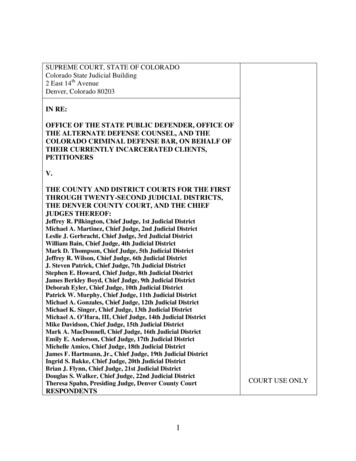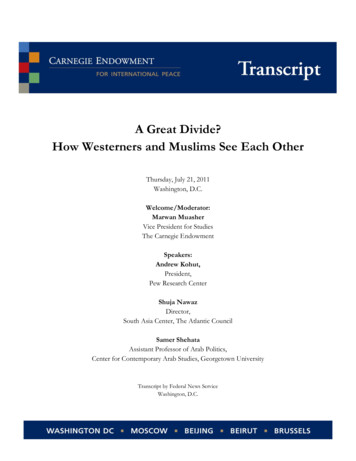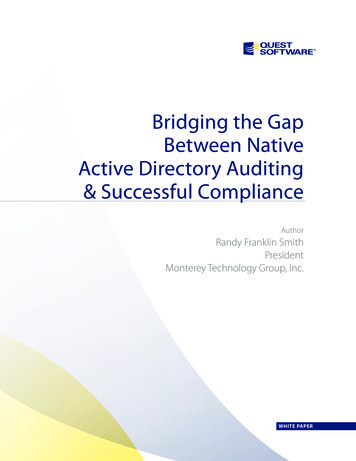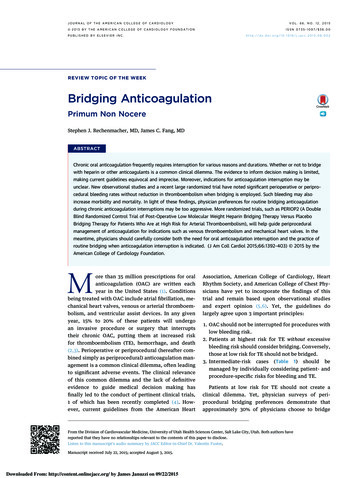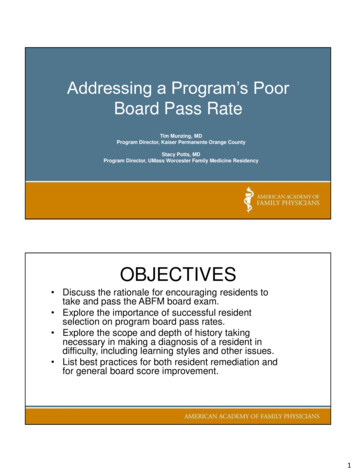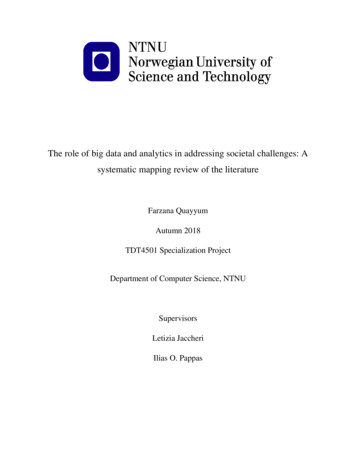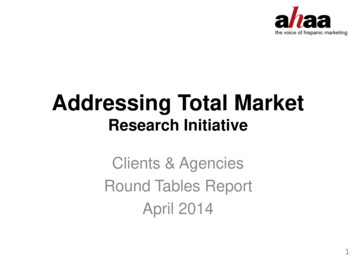
Transcription
B RIDG IN G T H E DI V I D E : A D D R E S S ING CO L O R ADO ’SS UBS TA N C E U S E D IS O R D E R NE E D SFEBRUARY 2017
Report produced by1 8 0 0 Gl e narm P l ac e , S ui te 503, D e n v e r , C 0 80202, 970/ 513. 5800 w w w . k e y s t o n e . o r gR e s e arc h b y O M NI I ns ti t u t e , 899 L o g a n S t r e e t , S u i t e 600, D e n v e r , C O 80203
TA B LE O F CO N T E N T SEXECUTIVE SUMMARY2SUBSTANCE USE DISORDERS IN COLORADO4STAKEHOLDER ASSESSMENT: KEY FINDINGS AND THEMES9REGION 112REGION 214REGION 316REGION 418REGION 520REGION 622REGION 724STAKEHOLDER PERSPECTIVES: POPUL ATION-SPECIFIC FEEDBACK26CONCLUS ION32REFERENCES33APPENDIX A: METHODOLOGY381
E X E C U T IVE SU MMA RYSubstance abuse is a key public health priority in the state of Colorado, having been identified as one ofColorado’s 10 Winnable Battles. A recently conducted analysis commissioned by the Office of BehavioralHealth and led by the Western Interstate Commission for Higher Education documented unmet needs forsubstance use disorder (SUD) services across the state. This comprehensive behavioral health needs analysisalso projected the extent of unmet need to increase significantly by 2025.1 Senate Bill 16-202, passed by theColorado General Assembly and signed by Governor John Hickenlooper, seeks to improve access to theseservices.To determine how to most effectively allocate increased funding for SUD services with Colorado’s ManagedService Organization (MSO) regions, the Keystone Policy Center (Keystone) conducted dozens of interviews,10 statewide meetings, and hundreds of surveys with key stakeholders to solicit feedback on gaps in services. The meeting, interview, and survey participants worked in the following sectors and organizations:mental health centers; substance use prevention, intervention, treatment and recovery providers; behavioralhealth organizations; county departments of human services; local public health agencies; law enforcement;homeless and veteran serving organizations; probation; primary care providers; regional care coordinationorganizations; hospital systems; crisis system; and state agencies. Alongside this stakeholder feedback effort,the OMNI Institute reviewed and synthesized existing sources of information regarding the needs and priorities for SUD services in Colorado. These joint efforts identified what is working well and prioritized needswithin each MSO region.Stakeholders across Colorado emphasized that when it comes to SUD services, the gaps and needs aresignificant and varied and nearly every population is underserved. Most regions shared similar concernsabout needs with respect to the workforce, residential treatment options, detoxification (detox) services,education and de-stigmatization, and supportive services, but — recognizing that needs vary greatly fromcommunity to community — stakeholders called for funding that is flexible at the regional and communitylevels, sustainable, and focused on the development of a continuum of care. Stakeholders recognized theimportance of funding non-crisis services — including prevention, intervention, treatment, and recovery — ifservices are to be effective over the long term.Across the state, stakeholders identified the financial challenges of building and sustaining a continuum ofcare due to disjointed and inflexible funding, inconsistent benefits, lack of consistent access to services, andthe inability to appropriately scale capacity in both rural and urban areas.Such variability in funding dis-incentivizes provider participation in offering these services; most providersincreasingly share feedback that their services have no source of reliable funding, with all sources, includingthe state, competing to be the “payer of last resort.” Indeed, this problem was identified by the Governor’sOffice of State Planning and Budgeting in the Behavioral Health Funding Study released in November 2016:[T]he requirement that providers use multiple methods for obtaining reimbursement for contractedservices creates an administrative burden and requires more resources be directed to these administrative and billing activities when the resource may be better allocated toward providing services toclients. One of [the Office of Behavioral Health’s (OBH)] reimbursement requirements, referred to asthe ‘capacity based protocol,’ provides an example of the complexity of the system From a provider perspective, the capacity based protocol presents challenges to plan for and provide services, as it2
E X E CU T IVE SU MMA RYcreates uncertainty as to what level of revenue will be available to staff and to operate the program.This uncertainty is proportional to the percentage of non-OBH revenue (cash receipts from non-OBHpayers) the program earns and the monthly or periodic variances in these non-OBH revenues. Theprotocol also does not allow programs to retain any excess earnings or offset expenses for capital expenditures, both critical considerations for expanding programs and maintaining or upgrading capitalequipment or building new facilities.2This topic has been raised during the 2017 legislative sessions — namely, the question of whether the statelegislature intends funding to be restricted by the payment protocol, resulting in “reversions” (funding thathad been appropriated by the legislature but that is returned or goes unused due to an inability to utilizethe funding, variability in other funding sources, or other challenges). This creates the inaccurate impression that the funding is not needed. Rather, the constraints on the funding often result in these reversions.Last year alone, approximately 1.7 million in SUD funding was reverted — funding that could have gone tosupport prevention, intervention, treatment, or recovery services if it had not been narrowly constrained inmany cases. Allowing providers and MSOs greater flexibility in how they may use funding to support theircommunities with needed services was a common request from stakeholders.Lastly, stakeholders raised specific funding challenges as they relate to the sustainability of services in ruralareas. Typically, services like an outpatient clinic may be easy to sustain in a larger population center, butin a rural area demand is not met by appropriate billing support. Thus, rural and frontier residents haveless availability to the entire continuum of services due to the often-mistaken belief that such services arecovered — sustained — by other payers. In the example of the rural outpatient clinic, that clinic may provideservices to only a handful of clients, though the clinic’s overhead costs remain fixed at a minimum level.Further, having qualified staff in rural areas is disproportionately challenging, with a given provider needingto offer better pay and benefits to compete against the staff leaving for a population center. As this examplemakes clear, service sustainability funding is needed to offset the gap in direct service reimbursement support from other payers.This report summarizes stakeholder feedback on general needs and gaps, needs and gaps related to specificpopulations, funding priorities, and promising practices for SUD services across the state and within theseven MSO regions.3
S U B S TA NC E U S E DISO RDE RS IN CO LO RA DOA rise in substance abuse poses serious challenges for Colorado families, community leaders and agencies,and treatment providers. According to the Substance Abuse and Mental Health Services Administration(SAMHSA), “substance use disorders occur when the recurrent use of alcohol and/or drugs causes clinically significant impairment, including health problems, disability, and failure to meet major responsibilities at work, school, or home.” 3 Access to SUD treatment is more important than ever: More than 255,000Coloradans misuse prescription drugs, and deaths involving the use of opioids nearly quadrupled between2000 and 2011. 4 According to new data from the Colorado Department of Public Health and Environment,5overdose deaths from just one kind of opioid painkiller outnumbered all homicides in Colorado in 2015. Inthat same year, there were 904 drug-induced deaths and 847 alcohol-induced deaths across the state. 6 Drugand alcohol-related deaths were most common among those aged 25-65, individuals of White, Hispanic, andAmerican Indian/Native Alaskan descent, and those living in areas of high poverty. 6In response to this growing epidemic, Senate Bill 16-202 seeks to increase access to effective SUD services,beginning with a stakeholder assessment process to identify priorities. In coordination with the statewideMSOs, Keystone conducted interviews, meetings across Colorado, and surveys with key stakeholders tosolicit feedback on gaps in services, identify what is working well, and prioritize needs to determine how tomost effectively allocate funding for SUD services within each MSO region.Continuum of Care for Substance Use Disorder TreatmentSenate Bill 16-202 directed an analysis of resources available to provide a continuum of SUD services, including prevention, intervention, treatment, and recovery support. Throughout this report and the feedback process, stakeholders refer to this “continuum of care,” which addresses the elements identified in the legislation as well as “enhancing health.” Individuals do not always move through the SUD continuum neatly and inone direction; due to the chronicity and the related risk of relapse with SUDs, individuals often move acrossand within different SUD treatment services, depending upon their needs and the services available to them.For instance, many individuals will complete detox on several occasions over the course of treatment andwill also utilize other services on the continuum at different points in their recovery process.4
S U B S TA NC E U S E DISO RDE RS IN CO LO RA DOSUBSTANCE USE CARE CONTINUUM.Enhancing HealthPrimaryPreventionEarly InterventionTreatmentRecovery SupportPromoting optimumphysical and mentalhealth and well-being,free from substancemisuse, through healthcommunications andaccess to health careservices, income andeconomic security, andworkplace certainty.Addressing individualand environmental riskfactors for substanceuse through evidencebased programs, policies, and strategies.Screening and detectingsubstance use problemsat early stage and providing brief intervention, as needed.Intervening throughmedication, counseling,and other supportiveservices to eliminatesymptoms and achieveand maintain sobriety,physical, spiritual, andmental health andmaximum functionalability. Levels of careinclude:Removing barriers andproviding supportsto aid the long-termrecovery process. Includes a range of social,educational, legal, andother services thatfacilitate recovery,wellness, and improvedquality of life. Outpatientservices; IntensiveOutpatient/Partial HospitalizationServices; Residential/Inpatient Services; and MedicallyManagedIntensiveInpatientServices.Figure 1: Source: U.S. Department of Health and Human Services (HHS), Office of the Surgeon General, Facing Addiction in America: The SurgeonGeneral’s Report on Alcohol, Drugs, and Health. Washington, DC: HHS, November 2016.The benefits of substance abuse treatment are well established. Numerous studies have demonstrated thepositive effect of treatment on reducing substance use and improving health status and social functioning.In addition to recovery from addiction, people who comply with substance abuse treatment often experience gains in family functioning, mental health, and employment. Despite this significant and growingbody of knowledge documenting that substance use addiction is a preventable, treatable and manageabledisease, and despite the proven efficacy of prevention, intervention, and treatment techniques, our statecontinues to pay for the consequences of substance abuse and addiction: illness, injury, death, and crime,overwhelmed social service systems, impeded education — which are not an effective use of taxpayer dollars. The following graphic illustrates the situation statewide as well as through a specific lens of spending inLarimer County.5
INVEST in SUCCESSPREVENTION, INTERVENTION & TREATMENTLOSING GROUNDCOLORADOSNAPSHOTSubstance Use Disorder is Skyrocketing in our Communities224KPEOPLE inCOLORADOmisuse prescriptionmedications every year1 7INHIGH SCHOOLSTUDENTShas taken prescriptionmedications without adoctor’s prescriptionspent onof all TREATMENTADMISSIONSare the result ofpainkiller overdosesfrom 2004 to 20133X12THMOREin 4 YEARSin the NATIONfor self-reportednonmedical use of opioidpainkillers in 2012-13 1.7182%UNINTENTIONAL DRUGPOISONING DEATHSDEATHS/YR.are for methamphetaminesACUTE SERVICES88%30019.1%Sources: Take Meds Seriously, State of Colorado,Colorado Consortium for Prescription Drug AbusePrevention; Colorado Department of Health andEnvironment; National Survey on Drug Use andHealth; Centers for Disease Control; ColoradoMeth Projectdeaths due to heroinin ColoradoSPENDING EXAMPLELARIMER COUNTYspent onTREATMENT 239Dollars are not being usedeffectively. Too many substanceuse disorder dollars are spenton acute services ratherthan treatment.12%THOUSANDMILLIONJail, emergency medical transport, hospital inpatient,emergency department, police contact and detoxificationOutpatient mental health and/or substance usedisorder treatment, and treatment provided throughAlternative Sentencing and Community CorrectionsSource: Larimer County High Utilizers Study 2015/2016, Health District of Northern Larimer CountyCOLORADOBETTERSUBSTANCE USE DISORDER PREVENTION, INTERVENTION &TREATMENT STRENGTHENS COMMUNITIES & SAVES DOLLARS 1SPENT ON RETURNSTREATMENTAS MUCH AS 7in reduced drug-related crime, criminal justice costs, and theftWHEN YOU ADD HEALTH-RELATED SAVINGS: fewer interpersonal conflicts;greater workplace productivity; and fewer drug-related accidents, including overdoses and deathsTOTAL SAVINGSexceed COSTS BY612:1Source: National Institute for Health
S U B S TA NC E U S E DISO RDE RS IN CO LO RA DOThe Colorado Office of Behavioral Health contracts with regional MSOs for the provision of SUD treatmentservices throughout Colorado.Colorado Managed Service OrganizationsRegion 1: Larimer, Weld, Morgan, Logan, Sedgwick, Phillips, Washington, Yuma, Elbert, Lincoln, Kit Carson, and Cheyenne CountiesRegion 2: Denver, Adams, Arapahoe, Broomfield, Douglas, Jefferson, Clear Creek, and Gilpin CountiesRegion 3: El Paso, Teller, Park, Lake, Chaffee, Fremont, and Custer CountiesRegion 4: Pueblo, Crowley, Kiowa, Huerfano, Las Animas, Otero, Bent, Prowers, Baca, Saguache, Mineral, Rio Grande, Alamosa, Conejos, and Costilla CountiesRegion 5: Archuleta, La Plata, Montezuma, Dolores, San Miguel, San Juan, Ouray, Hinsdale, Gunnison, Montrose, and Delta CountiesRegion 6: Mesa, Garfield, Rio Blanco, Moffatt, Routt, Eagle, Pitkin, Summit, Grand, and Jackson CountiesRegion 7: Boulder County7
S U B S TA NC E U S E DISO RDE RS IN CO LO RA DOAssessments of availability and need for SUD services underscore a shortage of SUD services across the spectrum,7 with a particular need in many regions for additional availability of social detox models.1 The Department of Health Care Policy and Financing reports that there are 18 detox facilities licensed by the Office ofBehavioral Health in Colorado, with 409 beds available between them.7Consumers in Colorado seeking SUD services can access LinkingCare.org, the directory for OBH licensed providers that allows consumers to search for some services on the SUD continuum, including: (1) emergency/medical detox providers; (2) residential treatment providers; (3) outpatient service providers; and (4) methadone clinic providers.8 Of these four service provider types, those locally (i.e., within-county) available thatconsumers can find through LinkingCare.org differ considerably from one region to another.For example, there are: 8 Six counties with none of these four service provider types available (Region 2: Gilpin; Region 4: Kiowa,Mineral, Dolores; Region 5: Hinsdale, San Juan); 12 counties with all of these four service provider types available (Region 1: Larimer; Region 2: Adams,Arapahoe, Denver, Jefferson; Region 3: El Paso, Fremont; Region 4: Alamosa, Pueblo, La Plata; Region 6:Mesa; Region 7: Boulder); and, 15 counties with only outpatient service provider types (i.e., no emergency medical/detox providers,residential treatment providers, or methadone clinic providers; Region 2: Broomfield; Region 3: Lake,Park, Teller; Region 5: Archuleta, Delta, Gunnison, Montezuma, Ouray, San Miguel; Region 6: Eagle,Grand, Jackson, Moffat, Rio Blanco).FundingFor SUD treatment, state and local funding are the largest payers, followed by Medicaid and other federalspending. Total private spending makes up a smaller component of funding.A brief examination of the distribution of SUD services funding for youth (ages 12-17) and transition-ageyouth (ages 18-24) conducted by the Office of Behavioral Health indicated that in FY 2011-12, the majority (80 percent) of youth SUD funding came from state funds and 37 percent of combined state and federalyouth SUD funding was derived from justice-involved youth dollars. Additionally, youth mental health/co-occurring services received 1.7 times as much funding as youth SUD services, and transition-age youth receivedmore than 1 million in SUD services than youth.8
S TAK EH O LD E R AS S E S SME N T : K E Y F IN DIN GS A N D T H EM ESKey Findings/ThemesWhile specific priorities for funding varied across the MSO regions, Keystone observed several key findingsand themes with respect to need for SUD services statewide:Care coordination and continuity of care across phases of the continuum: SUDs seldom occur in isolation.Consequently, mental, substance-use, and general health problems and illnesses are frequently intertwined,and coordination of all these types of health care is essential to improved health outcomes, especially forchronic illnesses. Improving outcomes depends upon the effective collaboration of all mental, substance-use,general health care, and other human service providers in coordinating the care of their patients.This disconnected care delivery system requires numerous patient interactions with different providers,organizations, and government agencies. It also requires multiple provider “handoffs” of patients for different services and transmittal of information to and joint planning by all these providers, organizations, andagencies if coordination is to occur. Overcoming these separations also is made difficult because of legal andorganizational prohibitions on clinicians’ sharing information about mental and substance-use diagnoses,medications, and other features of clinical care, as well as a failure to implement effective structures andprocesses for linking the multiple clinicians and organizations caring for patients. Stakeholders repeatedlyidentified the need for better linkages among mental, substance-use, and general health care and otherhuman service agencies caring for these patients. It is critical that individuals can access the services theyneed in a timely manner, particularly when in treatment or at risk for relapse. Stakeholders acknowledgedthat SUDs have not been treated, monitored, or managed like other chronic illnesses, nor has care for theseconditions been covered by insurance to the same degree.Additionally, stakeholders acknowledged the lack of a rational, integrated approach to SUD and the importance of using evidence-based early interventions to stop the addiction process before the disorder becomesmore chronic, complex, and difficult to treat. They stressed the importance of a development of and sustainable funding for a continuum of care (Figure 1), which refers to a treatment system in which clients entertreatment at a level appropriate to their needs and then step up to more intense treatment or down to lessintense treatment as needed.9 Sufficient c
research by omni institute, 899 logan street, suite 600, denver, co 80203. 1 table of contents executive summary2 substance use disorders in colorado 4 stakeholder assessment: key findings and themes 9 region

